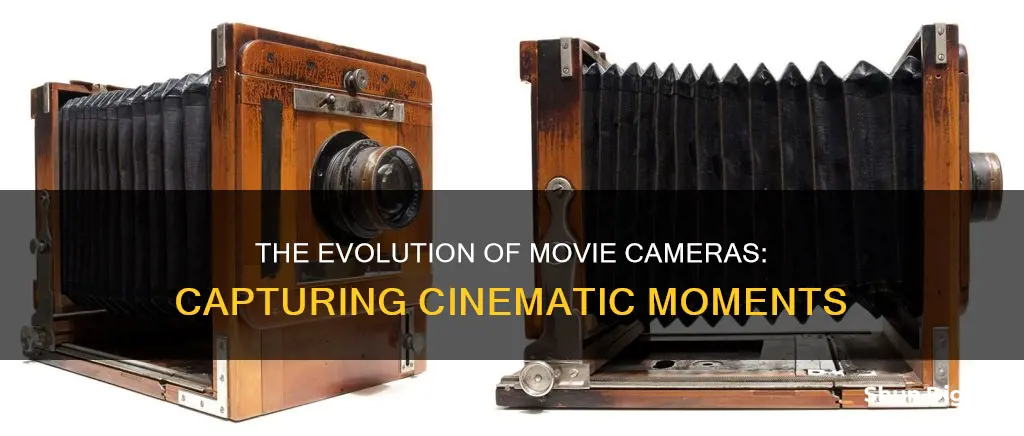
The movie camera, also known as a film or cine-camera, has its roots in the early 1800s, when the first permanent photograph was captured. The movie camera was invented through the work of many pioneers, including Thomas Edison, Louis Le Prince, Etienne-Jules Marey, and the Lumière brothers.
The first movie camera was created in 1888 by Louis Le Prince, who used it to shoot a brief silent film of people walking in a garden. However, Thomas Edison is often credited with the invention of the first movie camera, as he received a patent for his camera, the Kinetograph, in 1892.
The development of the movie camera was a significant advancement, allowing for the capture and playback of moving images, and paving the way for the film industry as we know it today.
| Characteristics | Values |
|---|---|
| Date of Invention | 1895 |
| Inventor | Louis Le Prince |
| First Film | Roundhay Garden Scene |
| Other Names | Film camera, cine-camera |
| Function | Takes a rapid sequence of photographs to produce a moving image |
| Image Sensor | Film stock or image sensor |
| Frame Rate | 24 frames per second or more |
| Forerunner | Machine invented by Francis Ronalds in 1845 |
| Chronophotographic gun invented by Étienne-Jules Marey in 1882 |
What You'll Learn

The camera obscura, the first camera ever created
The earliest documented explanation of this principle comes from Han Chinese philosopher Mozi (c. 470-391 BCE), who correctly argued that the inversion of the camera obscura image is a result of light travelling in straight lines from its source. The image (or the principle of its projection) formed by lensless camera obscuras is also referred to as a "pinhole image". Rays of light entering through a small hole in a barrier admit only the rays that travel directly from different points in the scene, and these rays form an image of that scene where they reach a surface opposite the opening.
The camera obscura was used to study eclipses without the risk of damaging the eyes by looking directly at the sun. It was also used as a drawing aid, allowing artists to trace the projected image and produce a highly accurate representation of the scene.
The first cameras were large enough to accommodate one or more people, and over time they evolved into increasingly compact models. By the time of Niépce, portable box camera obscurae suitable for photography were widely available. Johann Zahn envisioned the first camera small and portable enough for practical photography in 1685, but it took nearly 150 years for such an application to become possible.
Ibn al-Haytham (c. 965-1040 CE), an Arab physicist also known as Alhazen, made significant contributions to the understanding of the camera obscura. He is often credited with the invention of the pinhole camera and was the first to understand the relationship between the focal point and the pinhole. He also provided the first correct analysis of the camera obscura, offering the first geometrical and quantitative descriptions of the phenomenon.
The camera obscura was used as a drawing aid since at least around 1550. By the late 17th century, portable versions of the device housed in tents and boxes became commonly used for drawing purposes.
Airline-Approved: Small Cameras with Lithium Batteries
You may want to see also

The first photographic camera
The first film camera was invented by Thomas Sutton in 1859. Built using a wide-angle lens consisting of a water-filled glass sphere, it was the first-ever panoramic camera.
Replacing Your ADT Doorbell Camera Battery: A Step-by-Step Guide
You may want to see also

The Kinetograph, the first motion picture camera
The Kinetograph is widely considered to be the world's first motion picture camera. It was developed by Thomas Edison with the help of his assistant, William Kennedy Laurie Dickson, in 1890. The camera was based on the photographic principles discovered by still-photograph pioneers Joseph Nicephone Niepce and Louis Daguerre of France.
The Kinetograph used celluloid film, which was invented by George Eastman in 1889, and was powered by electricity. The film was cut to a width of 35mm and moved through the camera by means of a sprocket system designed by Dickson. The sprocket teeth engaged two rows of holes running the length of the film along its edges. The images, or frames, recorded on the film were each 25mm wide by 19mm high. The Kinetograph could accommodate up to 15 metres of film at a time and could record at a rate of about 40 frames per second.
Once the film was processed, it was shown using another device developed by Dickson, the Kinetoscope. This was not a projector but an individual viewing device that ran a continuous 47-foot film on spools between an incandescent lamp and a shutter. The film was displayed inside a cabinet with a peephole cut into the top, through which a single viewer could watch the successive images. A slotted disk rotating between the film and the lens gave the viewer a momentary glimpse of each passing frame, creating a lifelike illusion of people and objects in motion.
Charging Camera Batteries: Camping Essentials for Photographers
You may want to see also

The Cinematograph, the first projector
The Cinematograph, also known as the Cinématographe Léon Bouly, was invented and patented by French inventor Léon Bouly on 12 February 1892. The name "cinematograph" comes from the Greek for "writing in movement". Bouly's device was a combination of a movie camera and a projector. However, due to financial constraints, he was unable to develop his ideas further and maintain his patent, leaving the field open for others to adopt the name and improve on the technology.
In 1895, French brothers Auguste and Louis Lumière perfected the Cinématographe, creating a system that could take, print, and project films. Their invention was superior to Thomas Edison's kinetograph, which lacked a projector. The Lumières' cinematograph produced sharper images and offered better illumination. Weighing only 16 pounds (7.3 kg), it was also more portable than Edison's electrically powered camera.
The Cinématographe could project images onto a screen, allowing a large audience to view the moving pictures simultaneously. This was a significant improvement over Edison's kinetoscope, which only allowed one person at a time to view the images through an eyepiece. The first commercial, public screening of cinematographic films took place on 20 May 1895 in New York City, marking a pivotal moment in the history of cinema.
The Lumière brothers' first film, "Workers Leaving the Lumière Factory" ("Sortie de l'usine Lumière de Lyon"), was made in 1895 and showcased their innovative use of the cinematograph. The success of their initial public screening propelled the Cinématographe to popularity worldwide, entertaining people from all walks of life and social standings. The invention of the cinematograph played a crucial role in the development of the motion picture industry, paving the way for the widespread adoption of film projection in theatres.
Recharging Olympus Camera Batteries: A Step-by-Step Guide
You may want to see also

The first digital camera
Sasson's camera was a prototype and was never put into production. However, it paved the way for the development of digital photography and changed the way images are captured, processed, and shared. Today, digital cameras are widely used and have become smaller and more portable, with many integrated into mobile devices such as smartphones.
Wireless Camera Battery Life: How Long Do They Last?
You may want to see also
Frequently asked questions
The first movie camera was invented by Louis Le Prince, a Frenchman who emigrated to England. In 1888, Le Prince used a single-lens camera to shoot what is considered the first-ever movie, titled "Roundhay Garden Scene".
In a mysterious turn of events, Le Prince disappeared in 1890, before he could patent his invention and take it on tour in America. Le Prince's wife suspected foul play, presumably from one of his competitors in the race to develop the first movie camera. Some have even accused Thomas Edison of arranging Le Prince's assassination.
Thomas Edison and his assistant William Dickson unveiled the Kinetograph in 1890, which is widely recognised as one of the world's first motion picture cameras. In 1892, they patented the Kinestoscope, a machine that could project moving images onto a screen.







